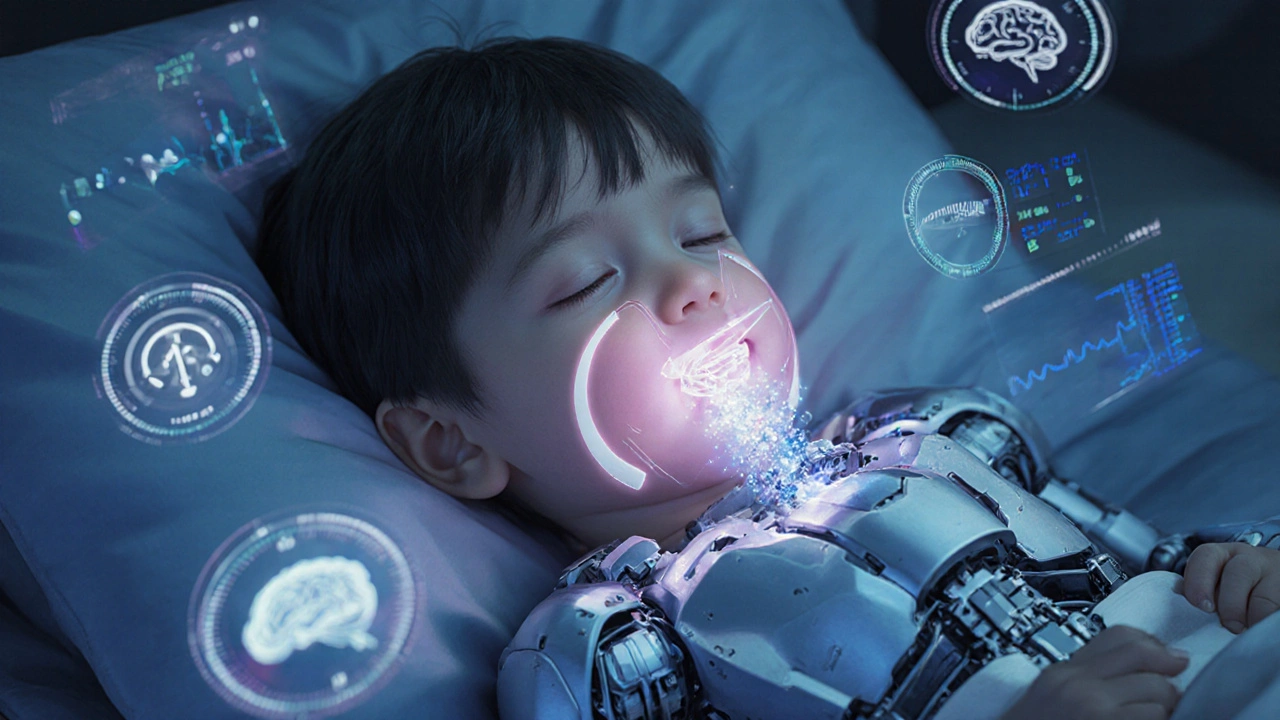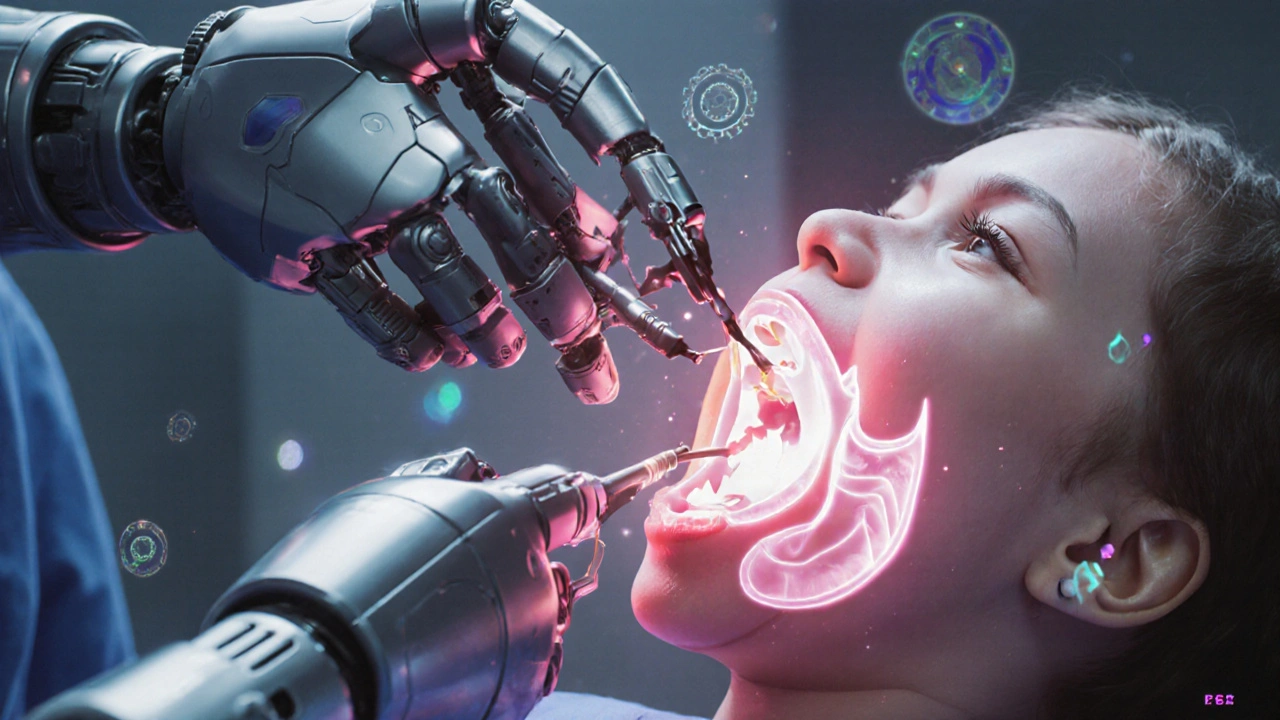 Nov, 23 2025
Nov, 23 2025
What is pediatric sleep apnea?
When a child stops breathing briefly during sleep-repeatedly-it’s not just snoring. It’s pediatric obstructive sleep apnea (OSA), a real and often overlooked condition. These pauses happen because the airway gets blocked, usually by enlarged tonsils and adenoids. Kids between ages 2 and 6 are most at risk because their airways are small, and their tonsils and adenoids are relatively large. This isn’t normal. It’s not just restless sleep. It’s the body struggling to breathe while trying to rest.
Each time the airway closes, the brain wakes the child up just enough to take a breath. These interruptions can happen 15 to 30 times an hour. That’s like being woken up every two minutes all night long. No wonder kids with untreated sleep apnea are tired during the day, have trouble focusing in school, or act out. Long-term, this lack of quality sleep can affect growth, heart health, and even brain development.
Why tonsils and adenoids are the main culprits
Tonsils and adenoids are lymphatic tissues meant to help fight infections. But in many kids, they grow too big-sometimes as big as golf balls-and block the back of the throat. This is especially common after repeated colds or allergies. When the child lies down to sleep, gravity pulls the soft tissues backward, and the enlarged tonsils and adenoids press against the airway like a door jammed shut.
Doctors don’t just guess this. They look for signs: loud snoring, mouth breathing, pauses in breathing, night sweats, bedwetting, or daytime fatigue. If these are present, a sleep study (polysomnography) is the next step. It tracks brain waves, oxygen levels, heart rate, and airflow. The results show exactly how bad the blockage is.
Here’s the key point: if the tonsils and adenoids are the main problem, removing them is the most direct fix. That’s why adenotonsillectomy-the surgery to remove both-is the first-line treatment recommended by the American Academy of Pediatrics. Studies show it works in 70% to 80% of otherwise healthy children with enlarged tonsils and adenoids. But it’s not always that simple.
Adenotonsillectomy: The go-to solution
Removing the tonsils and adenoids is a common surgery, but it’s not minor. It’s done under general anesthesia, and kids usually go home the same day. Recovery takes about a week to two. During that time, they need soft foods, lots of fluids, and rest. Pain is normal, but severe bleeding is rare-happening in about 1% to 3% of cases.
Some centers, like Yale Medicine, now offer partial tonsillectomy, where only part of the tonsil is removed. This reduces pain and bleeding by about half, and recovery is faster. But it’s not widely available yet. Most hospitals still do the full removal.
Why remove both? Because even if one looks bigger, the problem is often both. Dr. David Gozal, a leading expert, says leaving one behind can lead to the apnea coming back. That’s why complete removal is standard. Still, surgery doesn’t fix everything. About 17% to 73% of kids still have symptoms after surgery, especially if they’re overweight, have a craniofacial condition, or have other health issues.

When CPAP becomes the next step
If surgery doesn’t work-or isn’t an option-CPAP is the next best thing. CPAP stands for continuous positive airway pressure. It’s a machine that blows gentle air through a mask worn over the nose or face while sleeping. The air pressure keeps the airway open so the child can breathe normally.
For kids, the pressure is lower than for adults-usually between 5 and 12 cm H₂O. It’s not one-size-fits-all. A sleep study called a titration study is needed to find the right pressure. Too low, and it won’t work. Too high, and it’s uncomfortable.
CPAP is very effective when used correctly. Success rates are 85% to 95%. But here’s the catch: kids hate wearing masks. About 30% to 50% of children struggle to use it every night. They feel claustrophobic, the mask leaks, or they kick it off. That’s why pediatric sleep centers have special masks designed for small faces, and families get coached on how to help their child adjust. It can take weeks to get used to it.
CPAP is the preferred choice for children with obesity, neuromuscular disorders, or craniofacial abnormalities. It’s also used when OSA comes back after surgery. Mayo Clinic says it’s a solid option if medicines or surgery don’t work-which happens in about 15% to 20% of cases.
Other options: What else can help?
Surgery and CPAP aren’t the only tools. For mild cases, doctors sometimes try nasal steroids. These are sprays like fluticasone that reduce swelling in the tonsils and adenoids. They’re not a cure, but they can improve symptoms in 30% to 50% of kids with mild OSA. It takes 3 to 6 months to see results, so patience is needed.
Another option is rapid maxillary expansion. This is an orthodontic device worn in the mouth that slowly widens the upper jaw. It works best for kids with a narrow palate, which can narrow the airway. Success rates are 60% to 70%, but it takes 6 to 12 months. It’s often used alongside other treatments.
There’s also montelukast, a pill used for asthma and allergies. It targets inflammation linked to enlarged tonsils. Some studies show it helps reduce symptoms in mild OSA, but it’s not FDA-approved for this use in kids. It’s usually tried when surgery isn’t an option and steroids don’t help.
And yes-there’s new tech. Hypoglossal nerve stimulation, which gently stimulates the tongue to stay forward during sleep, got FDA approval for kids in 2022. But it’s still rare, expensive, and only used in extreme cases. Drug-induced sleep endoscopy is another tool doctors use to see exactly where the airway collapses during sleep, helping plan better surgeries.

What happens after treatment?
Even after surgery or starting CPAP, the job isn’t done. Kids need follow-up sleep studies, usually 2 to 3 months after treatment, to make sure the apnea is gone. Symptoms can return if the tonsils grow back, if the child gains weight, or if the CPAP mask doesn’t fit anymore.
CPAP masks need to be refitted every 6 to 12 months as the child grows. A mask that fit last year might be too tight or too loose now. That’s why regular check-ins with the sleep specialist matter.
For kids who had surgery, parents should watch for signs like snoring returning, daytime sleepiness, or trouble concentrating. If those happen, don’t wait. Call the doctor. The same goes for CPAP users-if the child stops wearing it consistently, or if they seem more tired, it’s time to reassess.
Choosing the right path
So how do you decide? Here’s a simple guide:
- If your child is 2-6 years old, has large tonsils and adenoids, and no other health problems: adenotonsillectomy is the best first step.
- If your child is overweight, has Down syndrome, cerebral palsy, or a facial abnormality: CPAP is often the better choice.
- If symptoms are mild and your child has allergies: try nasal steroids for 3-6 months.
- If the palate is narrow and the child is 7-10 years old: consider rapid maxillary expansion.
- If surgery didn’t help and CPAP is too hard: talk to your doctor about montelukast or newer options like nerve stimulation.
There’s no single answer. Every child is different. The goal isn’t just to stop snoring-it’s to help them sleep well, grow strong, and think clearly.
What parents should know
Many parents feel guilty if their child needs surgery or CPAP. But this isn’t your fault. Enlarged tonsils and adenoids aren’t caused by bad parenting or poor hygiene. They’re a biological issue.
What you can do: keep track of symptoms. Record snoring, pauses in breathing, daytime behavior. Bring that to your pediatrician. Don’t wait until your child is failing school or acting out. Early intervention matters.
And don’t give up on CPAP just because it’s hard at first. Most kids adjust. It takes time, patience, and support. The right mask, the right routine, and the right team make all the difference.